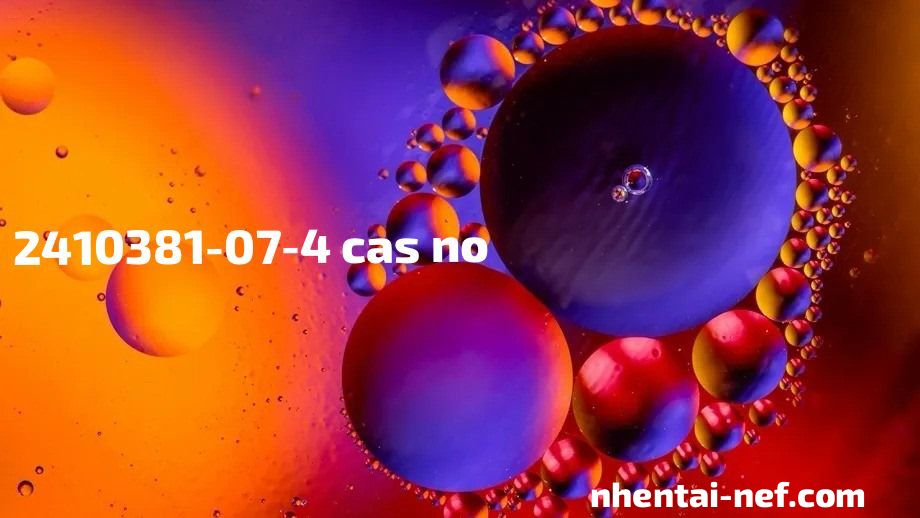
In the vast and intricate world of chemistry, the identification and classification of chemical substances are fundamental for effective research and application. One critical tool in this endeavor is the CAS (Chemical Abstracts Service) number, which assigns a unique identifier to each chemical compound. The CAS No. 2410381-07-4 has garnered attention in various scientific domains, serving as an essential reference for researchers, educators, and industry professionals alike. Understanding the Importance of 2410381-07-4 CAS No in Research, This article explores the significance of this specific CAS number, its applications across different fields of research, and its implications for future scientific advancements.
What is a 2410381-07-4 CAS No?
A 2410381-07-4 CAS No is a unique numerical identifier assigned to every chemical substance that has been described in the literature. Typically consisting of up to ten digits, these numbers are separated by hyphens and serve multiple essential purposes:
- Uniqueness: Each CAS number is distinct and refers to only one specific substance. This uniqueness is crucial for avoiding confusion between similar compounds or those with similar names.
- Simplification: The use of CAS numbers simplifies the identification of chemicals, facilitating effective communication across various scientific disciplines. Researchers, regulators, and manufacturers can reference the same compound without ambiguity.
- Database Access: CAS numbers provide a gateway to extensive databases that contain vital information about chemical properties, safety data, regulatory compliance, and research studies. This accessibility enables researchers to gather comprehensive data quickly.
In the case of CAS No. 2410381-07-4, it pertains to a particular compound with applications that extend across multiple research areas, underscoring its importance in contemporary scientific inquiry.
The Chemical Profile of 2410381-07-4 CAS No
To appreciate the significance of CAS No. 2410381-07-4, one must understand its chemical profile. While specific properties of the compound may vary, it is essential to consider several aspects:
- Chemical Structure: The molecular structure of a compound is fundamental to understanding its behavior and reactivity. For 2410381-07-4, researchers study its molecular composition, functional groups, and geometric arrangement. These characteristics influence the compound’s interactions with other substances and its overall stability.
- Physical Properties: Knowledge of a compound’s physical attributes is crucial for laboratory applications. Key physical properties of 2410381-07-4 may include:
- Melting Point: Indicates the temperature at which the substance transitions from solid to liquid, affecting its stability and handling.
- Boiling Point: Provides insight into the conditions under which the substance will evaporate, which is essential for distillation and purification processes.
- Solubility: Understanding the solubility of 2410381-07-4 in various solvents helps researchers determine suitable applications in chemical reactions and formulations.
- Density: Density influences how the compound is stored, transported, and mixed with other substances.
- Reactivity: The reactivity of a chemical compound refers to how it interacts with other substances. For 2410381-07-4, researchers investigate its potential reactions under various conditions. This knowledge is critical for predicting outcomes in chemical synthesis and understanding the compound’s behavior in biological systems.
Applications in Research 2410381-07-4 CAS No
The relevance of CAS No. 2410381-07-4 is highlighted by its applications across various fields of research. Its unique chemical properties enable researchers to utilize it in diverse experimental settings:
- Pharmaceutical Research: One of the most prominent applications of 2410381-07-4 lies in the pharmaceutical industry. The compound may serve as a potential lead in drug development, where researchers investigate its efficacy and safety as a therapeutic agent. Specific applications may include:
- Drug Formulation: Understanding how 2410381-07-4 can be incorporated into formulations to enhance bioavailability and effectiveness.
- Mechanisms of Action: Studying how the compound interacts with biological targets, such as enzymes or receptors, to determine its potential therapeutic effects.
- Toxicology Studies: Conducting research to assess the safety profile of the compound, identifying any potential adverse effects associated with its use.
- Biochemical Studies: In biochemistry, the interactions of specific compounds with biological systems are essential for understanding metabolic pathways and cellular processes. CAS No. 2410381-07-4 can be utilized in various biochemical assays, including:
- Enzyme Activity Studies: Investigating how the compound influences the activity of specific enzymes, providing insights into metabolic regulation.
- Receptor Binding Assays: Understanding how the compound interacts with cell receptors, contributing to the development of targeted therapies.
- Materials Science: The properties of materials can be engineered through the incorporation of various chemicals. CAS No. 2410381-07-4 may play a role in the development of advanced materials with specific characteristics. Applications in materials science may include:
- Polymers and Composites: Utilizing the compound to modify the properties of polymers, enhancing strength, flexibility, or thermal stability.
- Nanotechnology: Investigating how 2410381-07-4 can be used in the synthesis of nanomaterials for applications in electronics, energy storage, or environmental remediation.
- Environmental Science: Understanding the behavior of chemicals in the environment is crucial for assessing their impact on ecosystems. Researchers may study CAS No. 2410381-07-4 to gain insights into:
- Environmental Fate: Investigating how the compound degrades in different environmental conditions, including its persistence and potential accumulation in organisms.
- Toxicity Assessment: Evaluating the potential risks associated with the compound in environmental contexts, contributing to risk assessment and regulatory decisions.
Safety and Regulatory Considerations 2410381-07-4 CAS No
As with any chemical substance, safety is a paramount concern when working with CAS No. 2410381-07-4. Researchers must adhere to stringent safety protocols to minimize risks associated with handling the compound:
- Toxicity: Understanding the toxicity profile of 2410381-07-4 is essential for ensuring safe laboratory practices. Researchers must be aware of potential health hazards, exposure limits, and signs of toxicity. Safety data sheets (SDS) provide crucial information regarding:
- Acute and Chronic Effects: Identifying any short-term or long-term health effects associated with exposure to the compound.
- Exposure Routes: Understanding how the compound can enter the body (inhalation, skin contact, ingestion) and implementing measures to mitigate these risks.
- Regulatory Compliance: Many chemicals are subject to regulatory oversight, and researchers must ensure compliance with relevant regulations. This includes:
- Registration and Reporting: Some compounds may require registration with regulatory bodies, depending on their intended use and associated risks.
- Storage and Disposal: Proper storage and disposal protocols are essential to minimize environmental impact and ensure safety.
- Material Safety Data Sheets (MSDS): Comprehensive safety information is available through MSDS, which outline the chemical’s properties, hazards, handling instructions, and emergency measures. Researchers should familiarize themselves with these documents before working with the compound.
The Future of Research Involving 2410381-07-4 CAS No
The relevance of CAS No. 2410381-07-4 is expected to grow as scientific research continues to evolve. Several trends suggest that this compound will play an increasingly important role in future studies:
- Interdisciplinary Research: The convergence of various scientific disciplines, such as chemistry, biology, and materials science, will drive innovative research approaches. CAS No. 2410381-07-4 may serve as a crucial component in cross-disciplinary studies, leading to novel discoveries and applications. For example, collaborative projects between chemists and biologists may uncover new therapeutic pathways for diseases.
- Sustainable Chemistry: The push for green chemistry and sustainable practices in research may lead to increased interest in CAS No. 2410381-07-4. Researchers will seek to understand how this compound can be utilized in environmentally friendly processes, including:
- Biodegradable Materials: Investigating the potential of 2410381-07-4 in the development of materials that degrade naturally, reducing environmental impact.
- Green Synthesis: Exploring how the compound can be incorporated into synthetic processes that minimize waste and energy consumption.
- Advancements in Analytical Techniques: As analytical methods continue to improve, researchers will gain deeper insights into the properties and behavior of compounds associated with CAS No. 2410381-07-4. Techniques such as mass spectrometry, nuclear magnetic resonance (NMR) spectroscopy, and chromatography will enhance our understanding of the compound’s interactions and applications.
- Global Collaboration: The global nature of scientific research fosters collaboration among researchers from different regions and institutions. Sharing information related to CAS No. 2410381-07-4 can lead to a more comprehensive understanding of its potential uses and implications. Collaborative efforts may yield significant advancements in drug discovery, materials innovation, and environmental science.
- Data-Driven Research: The increasing availability of data analytics and computational modeling in scientific research will likely influence the study of CAS No. 2410381-07-4. Researchers may leverage big data and machine learning techniques to predict chemical behavior, optimize synthesis pathways, and identify new applications for the compound.
Conclusion
The CAS number 2410381-07-4 is not merely a series of digits; it represents a specific chemical substance with significant implications for scientific research and innovation. Its uniqueness as an identifier simplifies communication, facilitates data access, and enhances the clarity of research.
As researchers continue to explore the properties and applications of compounds associated with this CAS number, they contribute to the advancement of knowledge and innovation across multiple scientific domains. From pharmaceutical development to environmental studies, the impact of CAS No. 2410381-07-4 is likely to expand, leading to new discoveries and applications that benefit society.





